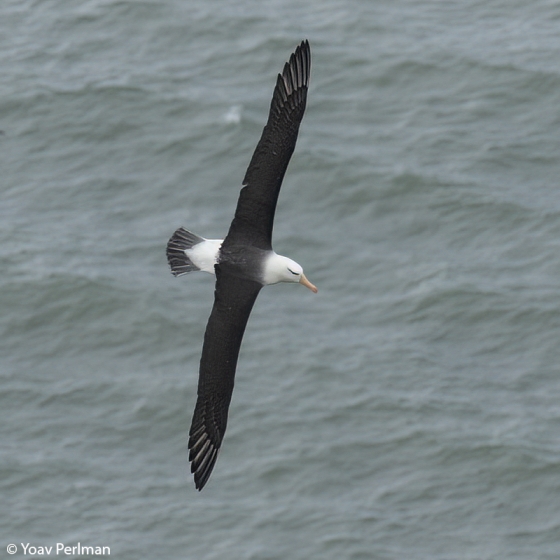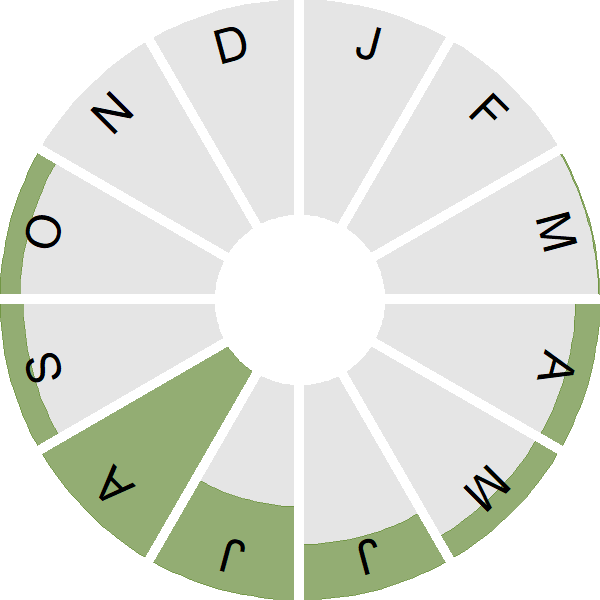Black-browed Albatross

Introduction
One of the smaller albatrosses, only a handful of individuals have been recorded here, but some have returned each summer (usually to a Gannet colony) for many years.
Perhaps the most famous of these visitors was "Albert" (fully Albert Ross), who first appeared on the Bass Rock in 1967, then subsequently at Hermanness, Shetland almost annually from 1972 to 1995.
In recent years another summering individual has joined Gannets at the Bempton Cliffs seabird colony in Yorkshire, giving many UK birdwatchers a chance to see this impressive species.

Key Stats
Status and Trends
Conservation Status
Population Size
Population Change
Population trends of this scarce species are not routinely monitored.
Distribution
This species is a rare vagrant and was recorded during Bird Atlas 2007–11 as shown on the map.
Occupied 10-km squares in UK
2007/08–10/11
or view it on Bird Atlas Mapstore.
Distribution Change
This vagrant is too rarely reported to map distribution change.
Change in occupied 10-km squares in the UK
Seasonality
With the exception of vagrant birds returning to seabird colonies, Black-browed Albatross is a very rare species with sporadic records during autumn seawatching season.
Weekly pattern of occurrence
The graph shows when the species is present in the UK, with taller bars indicating a higher likelihood of encountering the species in appropriate regions and habitats.

Movement
Britain & Ireland movement
Biology
Survival and Longevity
Survival is shown as the proportion of birds surviving from one year to the next and is derived from bird ringing data. It can also be used to estimate how long birds typically live.
Classification, names and codes
Classification and Codes
- Order: Procellariiformes
- Family: Diomedeidae
- Scientific name: Thalassarche melanophris
- Authority: Temminck, 1828
- BTO 2-letter code: AA
- BTO 5-letter code: BLBAL
- Euring code number: 140
Alternate species names
- Catalan: albatros cellanegre
- Czech: albatros cernobrvý
- Danish: Sortbrynet Albatros
- Dutch: Wenkbrauwalbatros
- Estonian: mustkulm-albatross
- Finnish: mustakulma-albatrossi
- French: Albatros à sourcils noirs
- German: Schwarzbrauenalbatros
- Hungarian: dolmányos albatrosz
- Icelandic: Svaltrosi
- Irish: Albatras Dú-Mhalach
- Italian: Albatros sopracciglineri
- Latvian: melnacu albatross
- Lithuanian: siauraakis albatrosas
- Norwegian: Svartbrynalbatross
- Polish: albatros czarnobrewy
- Portuguese: albatroz-de-sobrancelha
- Slovak: albatros ciernobrvý
- Slovenian: falklandski albatros
- Spanish: Albatros ojeroso
- Swedish: svartbrynad albatross
- Welsh: Albatros Aelddu
More Evidence
More evidence from Conservation Evidence.com
Partners
Citing BirdFacts
If you wish to cite particular content in this page (e.g. a specific value) it is best to use the original sources as linked in the page. For a more general citation of the whole page please use: BTO (20XX) BirdFacts Species: profiles of birds occurring in the United Kingdom. BTO, Thetford (www.bto.org/birdfacts, accessed on xx/xx/xxxx).

